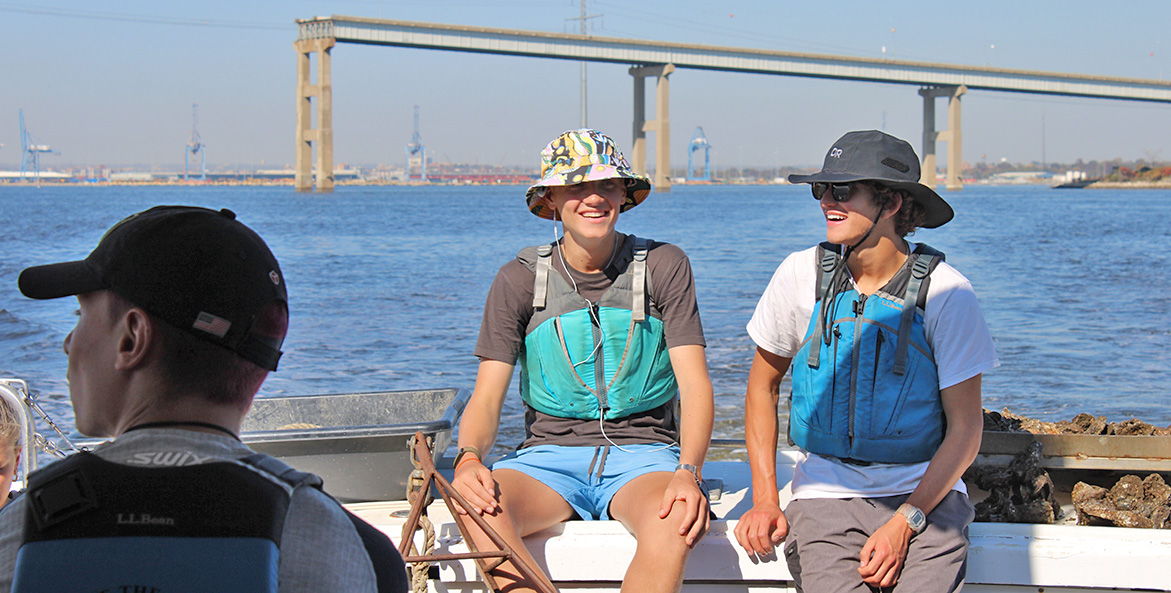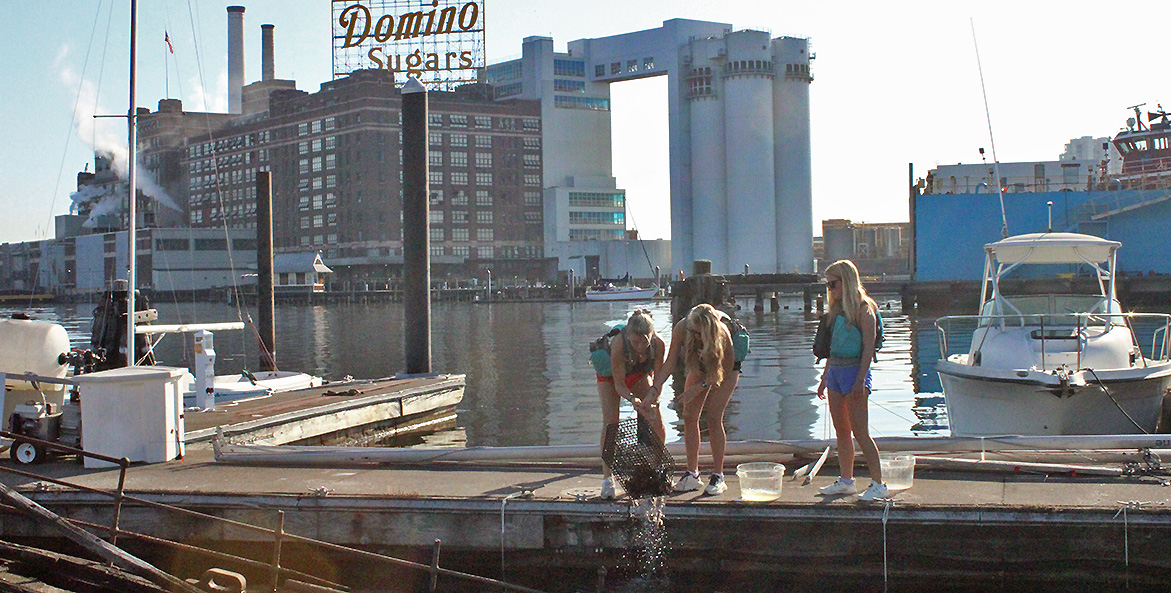High school junior Virginia has wanted to be a marine scientist for as long as she can remember. It’s one of the many reasons she signed up to spend nearly a full month learning at sea aboard Corwith Cramer with Sea Education Association (SEA). Like most of her classmates, who all attend Proctor Academy boarding school in New Hampshire but hail from across the country, Virginia saw this trip as a once-in-a-lifetime opportunity. And so far, it has not disappointed.
While sailing through the Gulf of Maine, Cape Cod Canal, and the open Atlantic Ocean, the students recounted seeing cresting whales, playful dolphins, stunning sunsets, glistening northern lights, and the brightest stars they’ve ever seen.
But on October 22, their views looked a little different for Corwith Cramer had just made its first and only port stop in Maryland’s Baltimore Harbor.

Two Proctor Academy students aboard the Snow Goose outside of Baltimore.
Valerie Keefer/CBF Staff
This wasn’t the original plan, SEA educator Ben Kochan said. Initially Corwith Cramer was routed to Bermuda. But unpredictable hurricanes, mixed with no refuge areas for the giant sailboat, made a dangerous mix, and the crew ultimately decided to reroute through the Chesapeake Bay.
And so, Bermuda turned to Baltimore—bummer . Even for the biggest Charm City fan, that’d be disappointing. For many students, it was their first time in the city, and first impressions varied.
“It kind of smells,” one student yelled.
“There’s less trash than I expected,” said another.
This visit would certainly be different from the rest of their travels. Their teachers saw that as a learning opportunity.
Like CBF’s education program, the goal of SEA is to spark a long-lasting love of our water resources and environment in the next generation of stewards.
“While Bermuda would have been cool, I think the learning opportunities here are much better. There’s so much history and will be a great comparison for other things they’ve seen,” Kochan said.
Like the rest of their studies, the class got to see Baltimore from a special perspective—the water. On a beautiful October day, they joined CBF’s Baltimore Harbor Education Program aboard our vessel, Snow Goose. The group took water quality samples, explored oyster cages, and saw the surprising biodiversity that lives under the Harbor’s surface.
When testing water quality, the students made an accurate prediction—this water is not as clean as what they tested out at sea. But as they cruised past industrial factories, wastewater treatment plants, and shipping terminals, the reason was clear: people. Nearly 600,000 people live in Baltimore City.
“The thing I noticed the most was the color,” said senior Molly, who wants to pursue marine conservation. “When you’re out [in the ocean], it’s vivid blue. When we were coming into the Harbor, the water was a completely different color.”
Her observations, and the role that people play in our shared environment, got Molly thinking about climate change.
“We haven’t discussed climate change much yet during the SEA program because we haven’t really seen it,” she added. “Here [in Baltimore] I feel like you can see it.”
As part of the SEA program, each student must pursue a science research project. Topics varied from seafloor sediment, to zooplankton, to marine plastics. The plastics group gathered samples throughout the day, including chip bags and water bottles. They’d bring their findings back onboard to Corwith Cramer’s lab.
Like CBF’s education program, the goal of SEA is to spark a long-lasting love of our water resources and environment in the next generation of stewards.
“Some students here are pursuing the sciences, and some just wanted a sailing adventure,” said SEA crew member, Jeff Schell. “I feel it’s my job to make them think the science part is interesting.”
That methodology seems to be working for junior Quinn. “I think one of the reasons I did this trip was to see if I could find an interest in marine biology or maritime studies,” he said. “And so far, it’s looking bright for that. I’m very interested in it.”
Engaging with these students who live and explore outside of the Chesapeake Bay watershed was a special treat for CBF’s staff as well. For more than 50 years, we’ve provided meaningful, hands-on outdoor experiences to students. Our Baltimore Harbor program in particular—thanks to the city’s unique combination of industrial history, new development, and resilient ecosystem—is the perfect place to study environmental health and climate change.
And while we know it’s not Bermuda, Baltimore and the Bay make amazing places to learn and grow a lasting love for our natural resources.
CBF is currently accepting applications for our spring 2025 one-day student field programs through November 22 . Sign up now!

Maryland Communications & Media Relations Manager, CBF
[email protected]
443-482-2023



